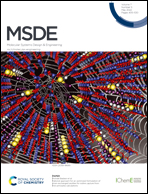Effect of supporting electrolyte on capacitance and morphology of electrodeposited poly(3,4-propylenedioxythiophene) derivatives bearing reactive functional groups†
Abstract
The interactions between the electrolyte and electroactive species in redox active PProDOT derivatives can be enhanced with better-performing electrodes for electrochemical energy conversion and storage. Differently functionalized 3,4-propylenedioxythiophenes (ProDOTs) are electropolymerized from acetonitrile using Et4NBF4, Et4NPF6, or NaClO4 as an electrolyte to evaluate the electrochemical performance of the considered polymer derivatives, as well as under monomer-free conditions. We propose a new equation to assess the kinetics of the diffusion-limited adsorption process with two independent solved parameters: diffusion slope k and power exponent b. Electron-donating groups attached to the monomer stabilize radical cation and dication formation during electrogrowth. The ProDOT–Br structure has a low oxidation potential owing to the electron-rich group in the heterocyclic structure, which grants access to a radical cation intermediate and interaction with the ions of the electrolyte. Surface roughness and morphology are assessed by atomic force microscopy and scanning electron microscopy, respectively. The changes in the Fourier transform infrared spectrum are more pronounced with the selection of electrolyte type than the type of derivatives. Except the –OBz derivative, the largest specific capacitance calculated from the area under the final cyclic voltammetry curves is obtained for Et4NBF4, followed by Et4NPF6 and NaClO4. In all systems, the –OPhCH2OH derivative exhibited the lowest electrolyte diffusion. More pronounced diffusion is observed for the PProDOT derivatives measured in Et4NPF6 and Et4NBF4 electrolytes, whereas the lowest diffusion is obtained for the NaClO4 electrolyte. Findings in this study provide new insights into the factors requiring attention upon tailoring assemblies for organic electronic applications.



 Please wait while we load your content...
Please wait while we load your content...